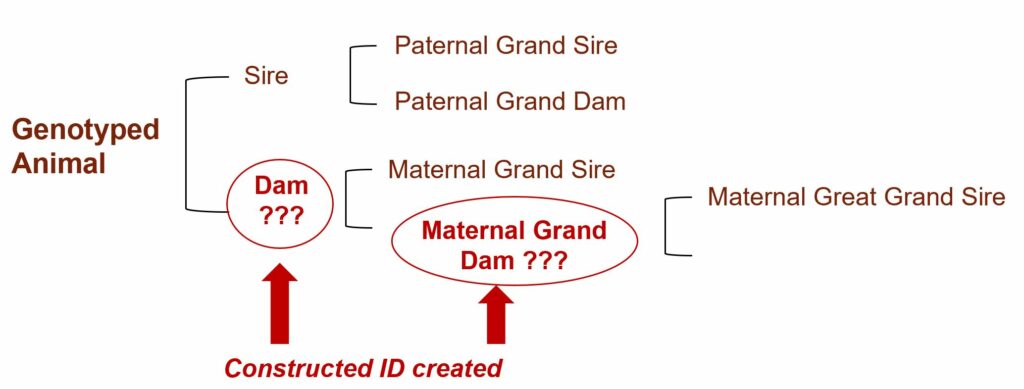Constructed ID’s: Eliminating Pedigree Dead Ends
Written by Lillian Bacheller , José Carrillo , Ezequiel Nicolazzi , George Wiggans
February 01, 2023

Knowing an animal’s ancestry several generations back is certainly the goal for breeders; however, there are instances where animals have a gap in their pedigree.
When animals have such a gap, like an unknown sire or dam, their assessment of genetic merit is incomplete. As animal breeders, we’ve hit a dead end. We’re not able to accurately factor ancestors’ contributions to the animal’s genetic merit. We’re not able to consider common bloodlines and make the best mating decisions.
To fill in more pedigree gaps, the Council on Dairy Cattle Breeding (CDCB) is implementing a new solution starting in February 2023. This new method – coined “Constructed ID’s – will build a more complete pedigree for animals that previously had no link to their maternal ancestors. As a result, the genetic evaluations for affected animals will be more accurate and reliable, so the U.S. genetic evaluations overall will improve in accuracy.
Let’s back up
Many pedigree gaps have been completed in the past decade with the evolution of genotyping and the use of genomics for parentage discovery. Paternal ancestors are often easily discovered or confirmed through genomic tools because most sires are genotyped.
Unknown maternal ancestors – dam and maternal grand dams (MGD) – are more difficult to identify because they are likely not genotyped. However, missing maternal male ancestors can be discovered and added to pedigrees. Because most dairy bulls over several generations have been genotyped, haplotype matching can accurately confirm, correct, or discover the sires, maternal grand sires (MGS), and even more distant ancestors with high accuracy.
Although modern haplotype matching allows us to identify the MGS and maternal great grand sire (MGGS), there’s a catch. Our U.S. system requires a specific dam identification to link in the MGS or MGGS.
Constructed IDs as the solution
Geneticists at the USDA Animal Genomics and Improvement Laboratory, research partner of the CDCB, have developed a tested, highly-accurate, peer-reviewed method to connect genotyped animals with their discovered ancestors. CDCB will create placeholder Constructed Dam IDs for the sole purpose of linking animals to their maternal grand sires and other ancestors discovered through genotyping and haplotype matching. This same methodology can be applied to create a Constructed MGD ID when the Maternal Great Grand Sire (MGGS) is discovered.

As this additional pedigree information is recorded, more accurate genetic evaluations will be calculated for affected animals.
Starting with the February 14, 2023, weekly evaluation, Constructed ID’s will be incorporated in the pedigrees of genotyped animals that have discovered MGS or MGGS. After the pedigree information has been added for relevant animals, the subsequent monthly and triannual evaluations will be more accurate with higher reliability. Gradually over the next several months, more than one million genotyped animals will be linked to additional pedigree information, resulting in more accurate U.S. genetic evaluations.
How will Constructed IDs be shown?
To be effective, Constructed IDs must be unique, traceable, stable and recognizable as a placeholder.
• Unique in the pedigree, as its purpose is to link source animals to their ancestors
• Traceable and connected to the source animal from which it was derived (and animal’s country)
• Stable, perpetually connecting the Constructed ID and its source animal – unless the true ancestor is found
• Recognizable as a placeholder and never considered as the ID of a true ancestor
Examples of Constructed Dam and MGD IDs for an animal of U.S. origin are shown below. For further recognition, the name of the constructed animal will be “Dam of [ID of source animal]” or “MGD of [ID of source animal].”

For animals of international origin, there are two differences:
- 3-letter breed code instead of 2
- Sex (F or M) after country code

Specifically how the Constructed IDs will be represented on reports and documents will be at the discretion of the breed associations, Dairy Records Processing Centers, genomic nominators and others producing those records.
How will Constructed IDs affect evaluations?
A.I. bulls typically have complete pedigrees, so the impact on these animals will be very limited.
The animals with added, or discovered, pedigrees will obtain a more accurate parent average, compared to when the Unknown Parent Group was used. The more accurate parent average will in turn impact the animal’s genetic evaluation.
How do we know this method works?
The genomic technology for parentage identification has been used for over a decade by CDCB and the USDA AGIL team, who have been pioneers in genetic improvement through genomics. Papers published in the Journal of Dairy Science in 2013 (VanRaden et al) and 2020 (Nani et al)
The bottom line
The implementation of Constructed ID’s simply allows CDCB to connect this well-tested technology to pedigrees of animals and avoid the pedigree dead ends caused by unknown ancestors. The Constructed IDs represent a new way to leverage genomic technology, to continually improve the accuracy of U.S. genetic evaluations, and to provide more complete pedigree information to producers as they make mating and management decisions.
For More Information
Find Constructed IDs FAQ (Frequently Asked Questions) and references at https://uscdcb.com/library/
Interbull Presentation and Proceedings, Montréal, Canada, May 30-June 3, 2022
Presentation: Adding and reporting genomically discovered ancestors in U.S. evaluations
Interbull Bulletin No 57: Adding and reporting genomically discovered ancestors in U.S. evaluations
J.A. Carrillo, R Mota, G.R. Wiggans, L.R. Bacheller, G. Fok, D. Null, E. Ogwo, P.M. VanRaden
Interbull
Published Papers
Nani, J.P., Bacheller, L.R., Cole, J.B., and VanRaden, P.M. Discovering ancestors and connecting relatives in large genomic databases. J. Dairy Sci. 103(2):1729–1734. 2020.
VanRaden, P.M., Cooper, T.A., Wiggans, G.R., O’Connell, J.R., and Bacheller, L.R. Confirmation and discovery of maternal grandsires and great-grandsires in dairy cattle. J. Dairy Sci. 96(3):1874–1879. 2013.
About the Authors
José A. Carrillo, Chief Data Officer, Council on Dairy Cattle Breeding
Ezequiel Nicolazzi, Chief Operation Officer, Council on Dairy Cattle Breeding
Lillian Bacheller, Senior Applications Developer, Council on Dairy Cattle Breeding
George Wiggans, Technical Advisor, Council on Dairy Cattle Breeding
About CDCB
The Council on Dairy Cattle Breeding (CDCB), in Bowie, Md., provides premier dairy genetic information services through industry collaboration centered around a mission to help optimize cow health and productivity in herds worldwide. The CDCB drives continuous improvement and maintains the integrity of the world’s largest animal database, building on a quality foundation with more than eight decades of recorded U.S. dairy animal performance. The CDCB is a collaborative effort between four sectors of the U.S. dairy industry: Dairy Records Providers (DRP), Dairy Records Processing Centers (DRPC), National Association of Animal Breeders (NAAB) and Purebred Dairy Cattle Association (PDCA).